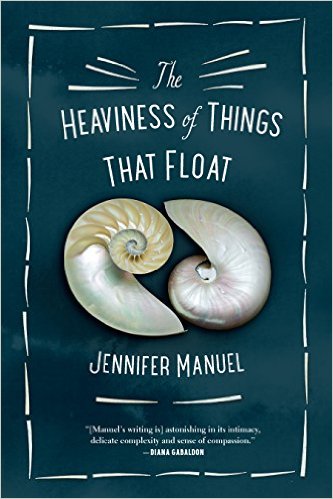
Review by Anjalika Samarasekera
The Heaviness of Things that Float
by Jennifer Manuel
Douglas & McIntyre, 2016
The cover of Jennifer Manuel’s debut novel, The Heaviness of Things that Float, depicts two seashells attempting a yin yang configuration. The shells do not touch and the gap, shaped like an hourglass, represents the forty years the novel’s protagonist, Bernadette Perkal, has spent living close to the Tawakin Reserve, a fictional place situated off the northern tip of Vancouver Island where “giant kelp bed(s) swimming with otters and . . . ridges of rocks where seals sometimes scrambled away from killer whales” are the norm. (48) Bernadette, nurse and sole occupant of a lonely medical outpost across the water from Tawakin’s twenty-five or so beaten and rotting houses, cares deeply for the families on the reserve, but she fears that as a white person, a mamulthni, she will never really belong. Only weeks from retirement, she is unsettled by what will become of her with no family of her own.
The first person account of Bernadette Perkal may be a work of fiction, but the story is drawn from Manuel’s experiences as a treaty archivist and schoolteacher on the lands of the Ktunaxa, Tahltan and Nuu-chah-nulth peoples. Manuel is aware of the difficulty of depicting the Tawakin people in a way that does not inadvertently reinforce negative stereotypes about Aboriginal communities and gives Bernadette insight into the limited nature of her own narrative. While taking the nurse who will replace her after she retires on a tour of the reserve, Bernadette observed: “It was not easy to tell these stories. So much sadness was bound up in their lives, yet their lives were so much more than just their sorrows. How should the reserve be explained to an outsider? I didn’t want to turn each home into a simple tale or reduce each family to a single tragedy. At the same time, I didn’t want to ignore the realities.” (186)
The question is whether it is enough to acknowledge the difficulty of telling another’s story or whether it is better to avoid reinforcing stereotypes altogether given that “the realities” in this case have been told most often by white outsiders and not by the communities themselves. As the Nigerian novelist, Chimamanda Ngozi Adichie, said in her TED Talk, “The danger of a single story”: “The consequences of the single story is this: It robs people of dignity. It makes our recognition of our equal humanity difficult. It emphasizes how we are different rather than how we are similar.” (July 2009)
Manuel’s Bernadette makes the opposite mistake: she sees herself as similar to the Tawakin people, blinding her to their differences. When Chase Charlie, a Tawakin man Bernadette loves like a son, goes missing after he leaves the water-locked reserve one afternoon in his trawler, Bernadette’s love for Chase and her conviction that she knows him better than anyone else, convinces her that Chase simply took to the water for some time alone. Privilege, in Bernadette’s case, is blindness: a failure to appreciate the impact of colonialism on Chase’s mental health and his hope for the future.
Privilege is also the power to control the facts. Bernadette’s depiction of Chase’s wife, Patty, reduces her to someone who drinks while pregnant, fails to supervise her little brother so he drowns, and in an uncomfortable scene involving a dog biting Chase and Patty’s daughter, is preoccupied with blaming the owner of the dog rather than showing concern for the child. But Manuel is wise to Bernadette’s limitations as a first person narrator and uses other Aboriginal characters such as Bernadette’s former lover, Frank, and Patty’s mother, Loretta, to remind Bernadette of her privilege and how its lens, discoloured by familiarity and age, keeps her from truly understanding Chase and the struggles of the Tawakin people.
The Heaviness of Things that Float is at its best when the tension between Bernadette as an outsider and the resistance of the Tawakin people to having their stories told for them is brought to the fore, most powerfully in the outcome of the search for Chase. As Bernadette concludes towards the end of the novel, “nobody could ever wholly know the heart of another, no matter which side of the unbalanced world they lived on.” (284) Like the reader, she comes to recognize that the shells on the cover may never touch but through listening and acknowledging “the dangers of presuming too much,” it might be possible for all stories to eventually rise to the surface.
Anjalika Samarasekera is a Vancouver writer and former criminal lawyer. She is currently pursuing her MFA through the Optional Residency Program at UBC.